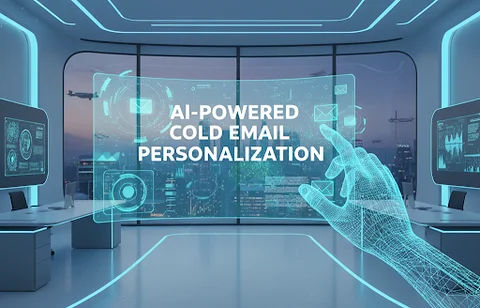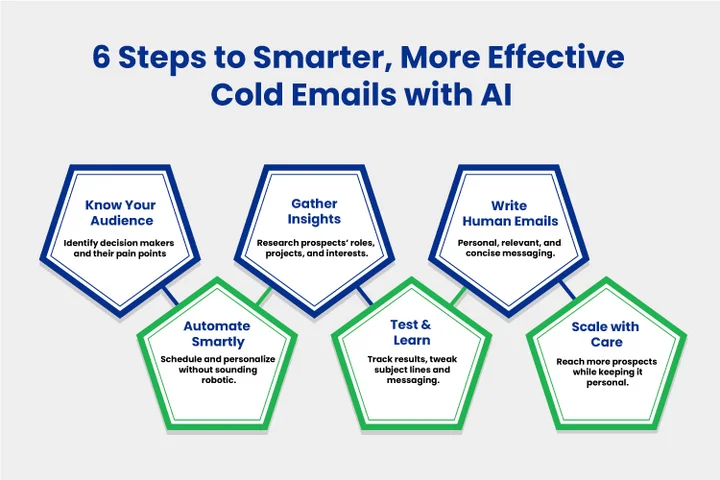
Your inbox is already packed, and your prospect’s? Even worse.
Every day, they get hundreds of emails, and let’s be honest… most of them never even get opened. So how do you make sure yours is the one that actually grabs their attention?
Cold emailing is tricky. You want to reach decision makers, but the reality is that most emails feel generic and get ignored.
That’s where AI comes to help. AI can analyze your prospects, pick up on the details that matter, and help you write emails that feel like they were made just for that one person. In fact, according to Africa Talks Business, 94% of organizations use AI to prepare or execute marketing, making AI-powered cold email strategies essential if you want your outreach to actually get noticed.
In this blog, we’re going to take you through a step-by-step AI cold email guide on how to use AI to personalize your emails, reach decision makers effectively, and turn your personalized email into messages people actually want to read.
What Is AI-Powered Email Personalization?
Let’s break it down.
AI-powered cold email personalization is all about helping you write smarter, more targeted emails that actually get noticed. Instead of guessing what might grab your prospect’s attention, AI gives you insights to craft messages that feel personal, relevant, and human.
Think of it as having a personal assistant who knows your prospects inside out and helps you communicate in a way that sparks real conversations.
Here’s how AI does it:
- Predictive Email Targeting
AI can scan LinkedIn profiles, company websites, and even social media updates using tools like Apollo.io or Lusha to uncover the details that matter. It helps you understand your prospect’s role, responsibilities, and current challenges so you can tailor your message to what’s actually relevant to them.
- AI-Driven Email Personalization
Once AI understands your prospect, it can help you craft emails that feel thoughtful and human. You’ll know exactly what to highlight to grab attention, spark curiosity, and make your email feel like it was written just for them.
- Automated Lead Generation Emails
AI takes care of the busywork, like scheduling, follow-ups, or generating multiple email variants, so you can spend more time adding your personal touch. This way, every email feels intentional, not like a mass message sent to hundreds of people.
With these tools, you’re no longer guessing what might work. You’re sending emails that connect, get read, and actually start conversations.
Now that you see what AI-powered personalization can do, let’s look at how you can put these techniques into action to reach decision makers every time you send a cold email.
How Can You Use AI to Make Every Cold Email Reach Decision Makers?
AI can do a lot more than just help you send emails faster. It can help you understand your prospects, personalize your outreach, and make sure your emails actually get read.

Below are the key steps to turn your cold emails into messages that connect:
Step 1: Know Your Audience Like a Friend
Before you even open your email tool, stop and ask yourself:
Who exactly are you emailing? And what keeps them up at night?
- Who is the decision maker you really want to reach?
- What challenges are they facing that your product or service can solve?
- What’s the one action you want them to take after reading your email?
When you answer these questions, AI can help you take it a step further. It can segment your audience, predict which messages will resonate, and even suggest personalization points for each prospect.
Now, instead of shooting in the dark, your emails are laser-focused.
Step 2: Gather Insights About Your Prospects
Here’s the part most people skip, but it makes a huge difference. You don’t want to guess what your prospect cares about; you want to know.
With AI sales tools and AI email marketing platforms, you can pull insights from:
- LinkedIn profiles for roles, responsibilities, and recent updates.
- Company websites for projects, product launches, and news.
- Social media activity to spot interests or content they engage with.
Once you have these insights, AI can help you craft emails that don’t just say “we can help you”, they say “I understand what’s going on in your world, and here’s how I can make it easier.”
That’s the kind of email that gets opened.
Step 3: Write Emails That Actually Sound Human
Now comes the fun part: writing emails that feel real. AI is there to help you, not replace you. Think of it as your co-pilot, suggesting ideas so you never stare at a blank screen.
Follow this simple framework:
1. Subject line: Make it short, relevant, and curiosity-driven.
Example: Quick idea to help [Company Name] save hours each week
2. Opening line: Reference something personal about them or their company, recent project, award, or news.
3. Body: Focus on their problem and how you can help. Keep it concise, use examples or numbers if possible.
4. Call to action: Keep it simple, like “Would you be open to a 15-minute call next week?”
Example:
“Hi [First Name], I saw your team just launched a new platform. We help tech companies like yours save hours each week by automating personalized outreach. Would you like to hop on a quick call to see if this could work for you?”
See how it’s personal, specific, and human? That’s what AI helps you scale without losing that touch.
Step 4: Automate Smartly, But Keep It Personal
Automation doesn’t mean sending robotic emails. AI Email automation is your helper, suggesting personalization, scheduling emails at the right time, and tracking engagement.
But always add your own touch. Even a small tweak, a word or phrase that sounds like you, makes the email feel human. AI does the heavy lifting; you add the personality.
Step 5: Test, Learn, Repeat
Even with AI, no email campaign is perfect right away. Each email you send tells you something about what works and what doesn’t.
Try these approaches:
- Test subject lines to see what gets opened.
- Experiment with body length; sometimes shorter is better.
- Track replies and clicks to see what resonates.
Over time, AI will learn from these results, helping you improve cold email response rates with AI. It’s like training a GPS: it guides you along the best route, but you’re still in control of the wheel.
Step 6: Scale Without Losing the Human Touch
Once you find a formula that works, AI can help you reach more decision makers without turning your emails into generic templates.
You can:
- Generate multiple personalized email variants quickly.
- Predict which prospects are most likely to engage.
- Automate thoughtful follow-ups.
This way, you’re reaching decision makers efficiently, and your emails feel intentional, not mass-produced.
Invalid emails slowing you down? Keep your list accurate and up-to-date so every message reaches the right inbox and drives results.
Pro Tips to Get Better Results from Your AI Cold Emails
Even with AI helping you craft emails, there’s no substitute for small human touches that make your messages pop. A few thoughtful tweaks can be the difference between an ignored email and a reply that starts a conversation. These are simple changes, but they can completely transform how your prospects respond.
Try these practical strategies to make every AI-powered cold email more effective:
- Be Brief: Decision makers are busy. Keep your emails concise and to the point so they can grasp your message in seconds.
- Add Credibility: Show that you’re trustworthy. Include client results, case studies, or examples to back up your claims.
- Write Naturally: Talk like you’re speaking to a colleague, not writing a formal letter. Emails that feel human get read.
- Focus on Benefits: Don’t just describe your product, show how it solves a problem or makes their life easier.
- Follow Up Thoughtfully: AI can schedule reminders, but your follow-ups should still feel personal and relevant, not like generic prompts.
Wrapping It Up
Cold emailing doesn’t have to feel like shouting into the void. With AI-powered cold email personalization, you can reach decision makers in a way that feels human, relevant, and noticeable. Following this step-by-step guide ensures your emails get opened and spark real conversations.
Start small, experiment, and refine your approach. AI-driven email personalization and email automation help you scale outreach without losing the personal touch. Pairing this with a reliable email validation tool makes sure your emails land where they should, improving overall response rates.
Your next email doesn’t have to get lost in the flood. Let AI help make it count!
Frequently Asked Questions (FAQs)
2. How Can AI Improve Your Cold Email Response Rates?
AI uses predictive insights and AI-driven email personalization to highlight what matters most to each prospect. It helps optimize subject lines, opening lines, and content so your emails are more likely to be opened and acted upon.
3. Can AI Handle Email Automation While Keeping It Personal?
Yes! Email automation with AI can schedule emails, send follow-ups, and generate personalized variants, but you maintain control over the message tone and personalization, making sure each email feels human.
4. How Do You Personalize Cold Emails With AI For B2B Outreach?
Use AI tools to gather insights from LinkedIn, social media, and company updates. Then craft emails that address their challenges and show how your solution helps. AI-powered email personalization for B2B makes your outreach more relevant and easier to scale.
Dead contacts holding back your outreach? Keep your list fresh, connect with the right people, and turn more emails into real conversations.
Leave a Reply